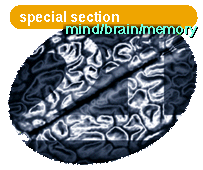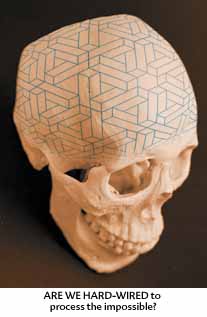

Multiple memory systems
By LYNN A. COOPER
 MENTAL
REPRESENTATIONS OF visual objects help guide everyday behavior(1). These representations serve two kinds of functions: the
automatic, unconscious computations required to anticipate the continuing structure of
objects that are obscured from view, and conscious knowledge of an object's identity, which
involves recognition of the object's meaning, function, and characteristics. In studying how
people access these distinguishable aspects of their mnemonic representations of objects, my
colleagues and I seek to unite questions about object representation with fundamental issues
in the study of memory.
MENTAL
REPRESENTATIONS OF visual objects help guide everyday behavior(1). These representations serve two kinds of functions: the
automatic, unconscious computations required to anticipate the continuing structure of
objects that are obscured from view, and conscious knowledge of an object's identity, which
involves recognition of the object's meaning, function, and characteristics. In studying how
people access these distinguishable aspects of their mnemonic representations of objects, my
colleagues and I seek to unite questions about object representation with fundamental issues
in the study of memory.The distinction between implicit and explicit memory underlies the concepts and methods of our work. By explicit memory, we refer to conscious, intentional recollection of recent experiences. This form of remembering is measured by standard tests of recognition and recall. Implicit memory, by contrast, refers to unintentional, non-conscious retrieval of information. This form of memory must be inferred from priming effects, or facilitation of performance on tasks that do not require conscious recollection of experiences.
Our work has been motivated by observations of patients with specific deficits of object recognition, especially those who can judge the structural equivalence of different views of an object but have trouble naming it or describing its functional and associative properties. These observations helped us develop some initial hypotheses: first, that separable systems might represent information about an object's component parts or global structure and information about its meaning, function, and characteristics; second, that structural aspects of the object's representation might be accessible primarily through implicit or indirect tests of memory, whereas semantic, functional, and distinctive aspects might be available to conscious, explicit memory.
A separate system for structure
WE DEVISED A procedure whereby subjects study drawings of unfamiliar three-dimensional structures: half of the drawings depict possible objects, with surfaces and edges connected so that they could exist in the 3-D world, and the other half impossible objects. In the study task or encoding phase, subjects are instructed to examine each object and form some judgment about it, unaware that a memory test is to follow.
Different groups of subjects are then tested for explicit or implicit memory of studied and non-studied objects: a yes/no recognition task ("I've seen that" or "I haven't seen that") measures explicit memory, and classification of objects as possible or impossible after brief exposure assesses implicit memory. In contrast to the recognition task, the subject's response in this task does not require conscious recollection of, or explicit reference to, a previous encounter with a presented object. More accurate decisions about previously studied objects than about unstudied objects constitute a priming effect.
Variation in how subjects are instructed to study or encode objects yields crucial information. We designed an initial series of studies to encourage extraction or representation of different kinds of information. In the structural encoding condition, subjects decided about the global arrangement of an object's parts by determining whether it appeared to face left or right; in local encoding, subjects indicated whether an object had more vertical or horizontal line segments (directing attention to local, 2-D aspects of objects, not global structural relations); in elaborative encoding, subjects described something familiar that each object reminded them of. Our central question is whether encoding of local features or meaning, as compared with structure, changes performance on implicit and explicit tasks, as inferred respectively from priming and recognition. Overall, the results accord well with our distinction between structural and non-structural (semantic or episodic) memory systems.
In one experiment, structural encoding robustly primed performance for decisions about possible objects but not impossible objects, implying that the structural description system that supports priming cannot compute 3-D representations of an object that could not exist in 3-D space. Explicit recognition was slightly higher for possible than for impossible objects. Neither local nor elaborative encoding, in contrast, produced priming effects. Elaborative encoding strongly increases explicit recognition, especially with repeated exposure to an object, which enhances perception of its unique features.
Changing the attributes of objects between study and testing, we have found, may vary performance on implicit and explicit memory tasks. If these changes modify priming or recognition effects, one may logically infer that the system supporting the affected task represents the attribute being varied; if no such variation occurs, the system being tested is not sensitive to that type of change. Size and left/right orientation affect priming and recognition differently. Change either of these qualities and subjects perform worse on recognition tasks, but the same changes do not diminish priming effects. The structural description system, unlike the episodic system, does not preserve information about size or orientation. Structural description seems to be concerned with the axis-based relations among a 3-D object's parts, whereas explicit recognition involves information about size and mirror-image reflection.
Why did two systems evolve?
WE AND OTHER investigators have turned to populations with memory deficits to obtain converging evidence for the two-system hypothesis. Amnesic subjects, unsurprisingly, fared much worse than matched and student controls on explicit recognition tasks, but priming on implicit object-decision tasks was roughly equivalent in the three groups. We have obtained similar results with older subjects, though their recognition was less severely impaired. The structural description system is apparently spared when the episodic system is impaired by advancing age or certain forms of brain damage. This arrangement makes adaptive sense: The structural system supports the ability to anticipate the changing structure of objects as the objects or observers move in space. Such an ability, fundamental for survival, may be less expendable than the capacity for episodic recollection of specific experiences.
During ordinary perceptual encounters with objects in the world, the two systems act in concert, but with appropriate manipulations, or after brain injuries, the systems are dissociable. The structural system, which mediates priming on our implicit memory task, appears dedicated to coding invariants of perceptual structure and ignores non-structural visual properties like object size. The episodic system, which typically supports performance on explicit memory tasks, seems dedicated to coding the semantic and visual information about an object's meaningful identity, function, and attributes.
The multiple-systems orientation is not the only possible theoretical account of our data, or of dissociations between implicit and explicit memory generally. Nevertheless, the apparent modularity of the systems leads to speculation that distinct neural pathways might contribute to structural and episodic representations of objects. This view gains support from recent studies employing positron emission tomography scans, which found increases in blood flow in inferior temporal regions associated with decisions about possible but not impossible objects. Conversely, increases of blood flow near the hippocampal formation associated with episodic recognition of possible objects. These findings are consistent with our proposal that a system involving inferior temporal regions is involved in the representation of a visual object's global 3-D structure. Studies with non-human primates implicate the same regions in computing size-invariant representations of global structure.
These encouraging findings are still highly preliminary. We are currently working to refine our understanding of the operations and underlying neural substrate of these systems. We hope to determine further the specificity of the individual systems and the nature of their collaboration to form a working visual memory system.
PHOTO & ART CREDITS:
Lena Lakoma/special effects by Howard Roberts.
Some material in this article is adapted from Cooper LA and Schacter
DL, "Dissociations between structural and episodic representations of visual
objects." Current
Directions in Psychological Science 1:5 (Oct. 1992): 141-146.
LYNN A. COOPER, Ph.D., is professor and
chairwoman of the Department of Psychology at Columbia.




